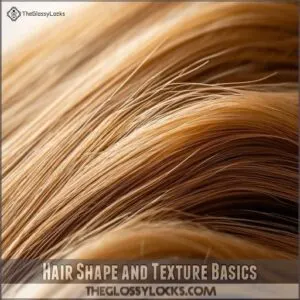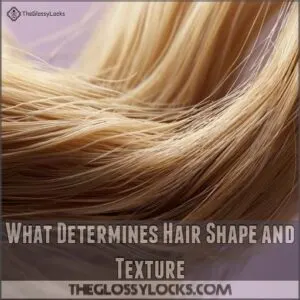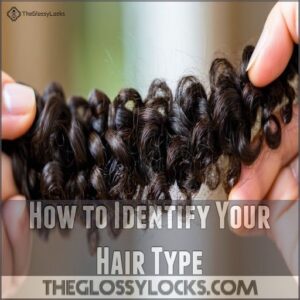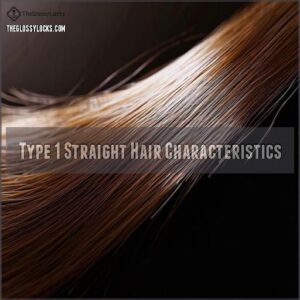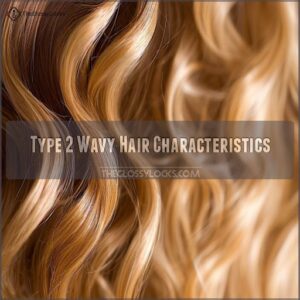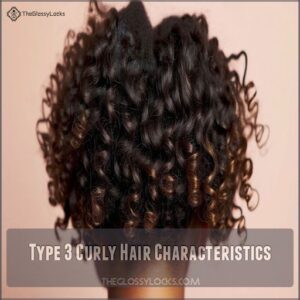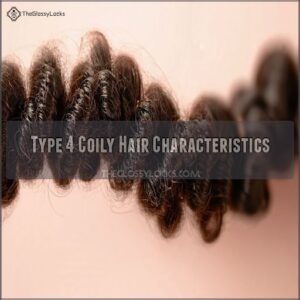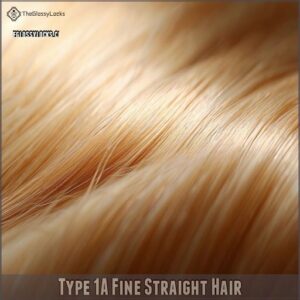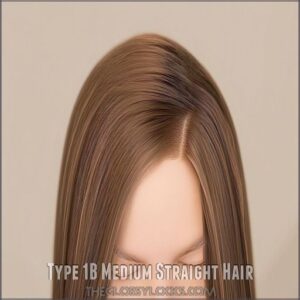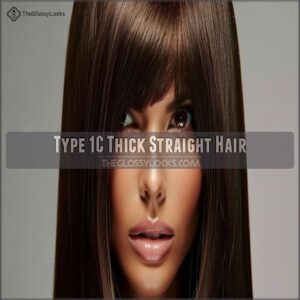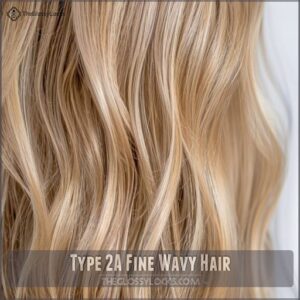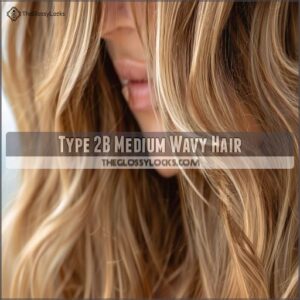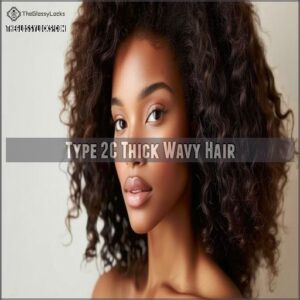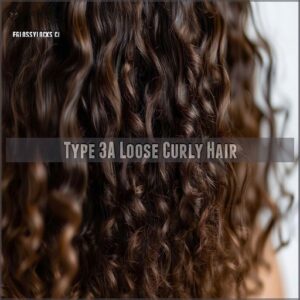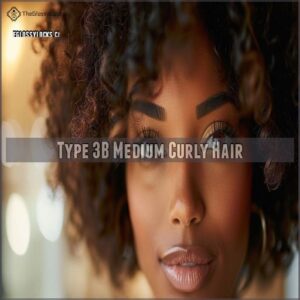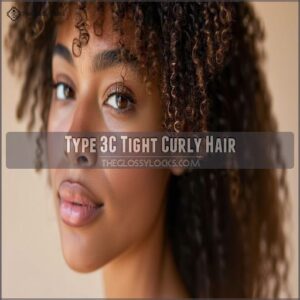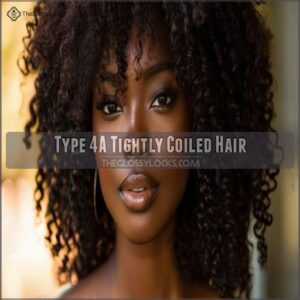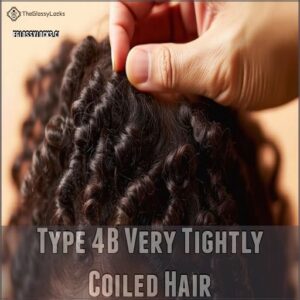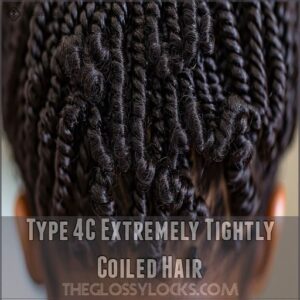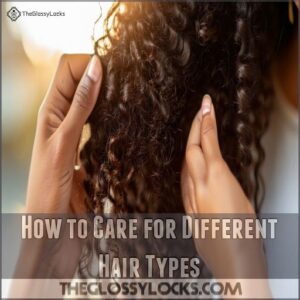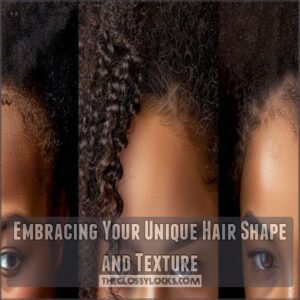This site is supported by our readers. We may earn a commission, at no cost to you, if you purchase through links.
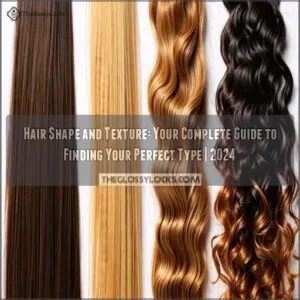 Your hair’s shape and texture are as unique as your fingerprint, determined by the shape of your follicles.
Your hair’s shape and texture are as unique as your fingerprint, determined by the shape of your follicles.
Think of them as tiny architects: round follicles create straight strands, oval ones craft waves and curls, while curved follicles design those beautiful coils.
You’ll find your hair falls into one of four main types: straight (Type 1), wavy (Type 2), curly (Type 3), or coily (Type 4).
Just like choosing the perfect outfit, understanding your hair type is key to realizing its full potential.
Each type has its own personality and care requirements – and yes, that explains why your friend’s miracle product might not work for you.
Table Of Contents
- Key Takeaways
- Hair Shape and Texture Basics
- What Determines Hair Shape and Texture
- How to Identify Your Hair Type
- Main Hair Types Explained
- Hair Type Variations and Subcategories
- Type 1A Fine Straight Hair
- Type 1B Medium Straight Hair
- Type 1C Thick Straight Hair
- Type 2A Fine Wavy Hair
- Type 2B Medium Wavy Hair
- Type 2C Thick Wavy Hair
- Type 3A Loose Curly Hair
- Type 3B Medium Curly Hair
- Type 3C Tight Curly Hair
- Type 4A Tightly Coiled Hair
- Type 4B Very Tightly Coiled Hair
- Type 4C Extremely Tightly Coiled Hair
- How to Care for Different Hair Types
- Embracing Your Unique Hair Shape and Texture
- Frequently Asked Questions (FAQs)
- What are the different types of hair texture?
- What determines hair type & texture?
- Do You Know Your Hair texture?
- What is hair texture?
- How do you know if a hair texture is curly?
- How does hair shape affect texture?
- How does hair shape relate to texture?
- What are the 4 types of hair texture?
- How do I figure out what hair type I have?
- What are the 12 hair types?
- Can pregnancy permanently change your hair texture?
- Why does hair become curlier in humid weather?
- Do certain vitamins affect hair texture and shape?
- Can swimming pools alter natural hair texture?
- Does hair texture change differently on medication?
- Conclusion
Key Takeaways
- You can identify your hair type by examining its natural curl pattern, strand thickness, and moisture retention, using the right products like best mousses for curly hair, allowing you to choose products and styling techniques that suit you best.
- Your hair’s texture and shape are determined by the shape of your hair follicles, with round follicles producing straight strands and oval or curved follicles creating waves and curls.
- Environmental factors like humidity, chemical treatments, and hormonal changes can temporarily alter your hair’s texture, highlighting the dynamic nature of your hair’s personality.
- Understanding the four main hair types—straight, wavy, curly, and coily—helps you identify unique characteristics, such as buckshot hair textures, to better understand and care for your hair. It helps you embrace your hair’s natural beauty and find the right care routine to maintain healthy, vibrant locks.
Hair Shape and Texture Basics
You’ll discover that your hair’s unique shape and texture comes from the natural form of your hair follicles, which can be round, oval, or curved.
Whether you’ve got pin-straight strands or bouncy coils, understanding your hair type will help you choose the right products and styling techniques that’ll make your locks look their best.
Hair Type Classification
Your hair’s unique identity comes from its natural curl pattern, ranging from poker-straight to tightly coiled.
The Andre Walker Hair Classification System breaks this down into four main types (1-4) and three subcategories (A-B-C), creating twelve distinct patterns.
This classification depends on your hair follicle’s shape – round ones create straight strands, while oval or curved follicles produce waves and curls.
Factors Affecting Hair Type
Just when you think you’ve nailed your hair type, life throws a curveball.
Hormonal changes, like during puberty or pregnancy, can alter your hair texture.
Age impacts hair too, making it drier and more fragile.
Chemical treatments, heat styling, and even your diet and stress levels come into play, reshaping your hair’s personality over time.
What Determines Hair Shape and Texture
Three key factors determine your hair’s shape and texture: genetics, follicle shape, and environmental influences.
Think of your hair follicles as tiny molds – their shape directly impacts how your hair grows. Round follicles produce straight hair, while oval or asymmetrical ones create waves and curls. If you have wavy hair, finding the right wavy hair products can make a big difference in managing your locks. It’s like having a built-in styling tool right at the root!
Your genetic makeup, passed down through generations, plays the starring role in this show.
But don’t think you’re stuck with what nature gave you. Environmental factors like humidity, chemical treatments, and heat styling can temporarily alter your hair’s texture. Even hormonal changes during pregnancy or menopause might surprise you with a texture makeover.
Remember, your hair’s character isn’t set in stone – it’s a dynamic feature that can change throughout your life.
How to Identify Your Hair Type
You’ll discover your true hair type by examining three key features: your natural curl pattern, strand thickness, and how well your hair holds moisture.
Once you know your hair type, you can choose the right products and styling techniques that’ll work best for your unique locks, saving you time and money on trial and error.
Determining Hair Texture
Determining hair texture starts with a simple at-home test after a fresh wash.
Run your fingers through damp, product-free hair and notice how it feels.
Fine hair slips through easily, while medium strands feel like cotton thread, and coarse hair has a rope-like texture.
Understanding hair porosity levels can also provide insights into how your hair absorbs and retains moisture.
Consider genetic factors too – your family tree often holds clues about your natural texture patterns and potential changes over time.
Hair Porosity and Moisture
Knowing your hair’s ability to absorb and retain moisture, often determined by its cuticle structure and density, is crucial for effective hair care. Understanding hair porosity helps you manage moisture retention like a pro.
Test yours by dropping a strand in water: if it floats, you’ve got low porosity; if it sinks, it’s high.
For low porosity, focus on lightweight products.
High porosity benefits from heavy oils and deep conditioning.
Tailor your routine for healthy, vibrant locks!
Identifying Curl Patterns
Taking the big chop journey can be a great way to reveal your natural texture and needs. Your curl pattern is like a unique fingerprint, telling the story of your hair’s natural texture and needs.
Want to decode your curl type?
Here’s how to crack the code:
- Considering your hair type, such as dry hair that needs washing every 2-3 days, wash hair with a clarifying shampoo to remove product buildup
- Air dry without touching or manipulating your strands
- Observe your natural curl formation in its purest state
- To determine your hair type, it’s essential to understand the historical context of hair typing systems, such as Andre Walker’s Curl Typing System, which categorized hair into four main types, understanding hair texture origins. Compare your pattern to standard hair type charts
Main Hair Types Explained
You’ll find your hair falls into one of four main types: straight, wavy, curly, or coily, each with its own unique characteristics and care needs.
Understanding your hair type will help you choose the right products and styling techniques for your perfect hair day.
Whether you’re rocking pin-straight strands or bouncy coils.
Type 1 Straight Hair Characteristics
Straight hair glides like silk through your fingers, characterized by its smooth, sleek appearance.
Type 1 hair grows from perfectly round follicles, creating that signature pin-straight look.
While it’s often envied for its natural shine and manageable texture, Type 1 hair tends to get oily quickly and can struggle with holding curls or volume.
Type 2 Wavy Hair Characteristics
Wavy hair falls between straight and curly textures, creating beautiful S-shaped patterns that can range from barely-there bends to defined waves.
While straight hair might need help holding curls, your waves naturally add volume and movement to your style. Think of waves as hair’s way of adding a bit of flair without going full ringlet.
- Type 2A waves are gentle and easily straightened
- Type 2B creates defined S-patterns from mid-shaft
- Type 2C shows waves from the roots with more body
- Waves become more pronounced when wet or with proper products
- Your waves might look different day-to-day based on humidity and styling
Type 3 Curly Hair Characteristics
Looking at Type 3 hair, you’ll notice springy, well-defined curls that form an "S" pattern from root to tip.
Think of these curls as nature’s perfect coils – they’ve got personality and bounce.
Unlike wavy hair types, Type 3 curls are more prone to dryness and frizz, but with the right care routine, they’ll spring to life like a garden in full bloom.
Type 4 Coily Hair Characteristics
Coily hair, also known as Type 4, stands out with its unique spring-like pattern that forms tight, defined coils from root to tip.
If you’ve got Type 4 hair, you’ll notice your strands create distinct Z-shaped or S-shaped patterns, with a naturally voluminous appearance.
Type 4a hair, characterized by medium-sized S-shaped curls, is particularly prone to frizz and breakage.
This hair type is incredibly versatile but needs extra moisture and gentle handling to maintain its beautiful, natural structure and prevent breakage.
Hair Type Variations and Subcategories
You’ll find your exact hair type among twelve distinct variations, ranging from pin-straight 1A to springy 4C coils.
Your hair’s unique personality comes from its follicle shape, which affects everything from how it grows to which products will work best for your daily styling routine.
Type 1A Fine Straight Hair
Type 1A hair is the finest and straightest of all hair types.
If you’ve got this silky-smooth variety, you’ll notice your strands are ultra-thin and lie completely flat against your scalp.
While it’s naturally shiny and soft, this hair type can struggle with volume and gets oily quickly.
Think of it as delicate silk threads that need gentle handling and lightweight products to maintain their natural beauty.
Type 1B Medium Straight Hair
With Type 1B hair, you’re in the middle ground of straight hair types.
It’s got a bit more volume than its finer cousin, Type 1A.
To keep your 1B hair healthy and full of life, try products that enhance natural shine and body.
Styling 1B hair is a breeze—just add some lift with lightweight mousse or volumizing spray.
Type 1C Thick Straight Hair
Naturally blessed with thick, straight hair, 1C types often find their strands have a mind of their own.
Your hair resists curls but maintains impressive volume and fullness.
While it might feel coarse and stubborn, this resilient texture actually gives you styling versatility.
You’ll need weightless products to tame occasional frizz without compromising your hair’s natural body.
Regular trims help manage bulk and keep your style polished.
Type 2A Fine Wavy Hair
Leaving behind thick straight strands, imagine waking up to 2A fine wavy hair.
It’s like a gentle ocean wave on a calm day.
This hair type’s thinness means more volume but watch out for frizz.
Opt for lightweight styling products to maintain bounce and shine, while keeping the frizz at bay.
Enjoy the easy maintenance and playful texture!
Type 2B Medium Wavy Hair
Type 2B hair brings medium-thick waves that start from the mid-length of your strands.
Think beachy waves with a bit more attitude – they form distinct S-patterns that give your hair natural movement and body.
Your waves need just the right balance of moisture and hold to shine.
While styling options are plenty, lightweight products work best to avoid weighing down those beautiful, defined waves.
Type 2C Thick Wavy Hair
While 2B waves flow gently, 2C waves mean business.
Your thick, coarse strands form well-defined S-waves right from the roots, often with a mind of their own.
Think beachy waves on steroids – they’re gorgeous but can get frizzy without the right hair care routine.
Styling products like leave-in conditioners and wave-enhancing creams are your best friends for frizz control and definition.
Type 3A Loose Curly Hair
If you’ve got those signature S-shaped curls that bounce with life, you’re likely rocking Type 3A hair.
Your loose, springy curls are about the width of a sidewalk chalk and tend to form defined spiral patterns.
For a hair care routine that works with your 3A locks, consider incorporating products from a 3A hair routine to bring out the best in your curls.
Here’s what makes your curls unique:
- Natural shine that catches the light beautifully
- Curls start forming right from the scalp
- Each curl loop measures around 1-2 inches in diameter
Type 3B Medium Curly Hair
Moving beyond looser curls, medium-tight 3B hair forms springy ringlets about the size of a Sharpie marker.
Your curls likely start from the roots and create that perfect spiral pattern everyone envies.
Managing frizz is your daily challenge, but here’s the silver lining: with the right styling products and hair routine, you’ll achieve amazing curl definition that holds its shape beautifully.
Type 3C Tight Curly Hair
Type 3C curls are nature’s corkscrew masterpiece – tight, springy spirals that bring enviable volume and personality to your hair game.
These defined curls pack a punch with their pencil-sized circumference, but they’re often thirsty for moisture.
You’ll notice your curls forming tight, bouncy ringlets that respond beautifully to leave-in conditioners and curl-defining creams.
Regular deep conditioning helps maintain their stunning natural pattern.
Type 4A Tightly Coiled Hair
People with 4A hair rock those springy, tightly coiled S-shaped curls that form perfect spirals when moisturized.
Your strands have a defined curl pattern that’s visible even without product, though you might experience significant shrinkage.
Think pen spring-sized coils that bounce back when stretched.
With the right moisturizing routine and gentle detangling techniques, these beautiful coils maintain their shape and shine beautifully.
Type 4B Very Tightly Coiled Hair
Got 4B hair? It’s a wild ride!
Expect super tight, Z-shaped coils, often with significant shrinkage.
Detangling‘s a challenge—gentle, wide-tooth combs are your best friend.
Protective styles, like braids or twists, are lifesavers.
Deep conditioning is key, and you’ll want products designed for moisture retention.
Embrace your unique texture—it’s gorgeous!
Type 4C Extremely Tightly Coiled Hair
Featuring the tightest coil pattern of all hair types, 4C hair showcases a stunning zigzag formation that’s often misunderstood. You’ll notice intense shrinkage and a delicate texture that requires extra TLC.
Here’s what makes 4C hair truly special:
- Incredible versatility for protective styles
- Maximum shrinkage potential (up to 75%)
- Superior ability to hold sculptural styles
- Natural resistance to humidity once properly moisturized
How to Care for Different Hair Types
You’ll find that caring for your unique hair type doesn’t have to feel like solving a complex puzzle, as each texture simply needs its own special combination of moisture, protection, and the right products.
Whether you’re working with straight, wavy, curly, or coily hair, you’ll learn how to keep your locks healthy and manageable with techniques that work specifically for your hair pattern.
Moisturizing and Hydrating Hair
Understanding your hair’s thirst for moisture can make a world of difference in your daily routine.
Natural oils and hydration keep your strands healthy, but each hair type needs a different approach.
Fine hair might need lightweight leave-in conditioners, while coily textures thrive with rich hair masks.
Try mixing honey with your conditioner for a DIY deep treatment that’ll make your hair sing.
Heat Styling and Protective Styles
Heat styling might seem like a quick fix, but it’s worth knowing both the pros and risks.
While flat irons and curling wands can create stunning looks, they can also damage your strands over time.
That’s where protective styles come in – braids, twists, and updos give your hair a break while looking fabulous.
Think of protective styling as a cozy blanket for your locks.
Using The Right Hair Products
Choosing the right hair products often feels like solving a puzzle, but it doesn’t have to be complicated.
For straight hair, lightweight serums and volumizing sprays work wonders.
Wavy hair thrives with salt sprays and light mousse.
Curly hair needs rich leave-in conditioners and defining creams, while coily hair benefits from intense moisturizers and natural oils.
Always check ingredients and avoid sulfates and parabens.
Embracing Your Unique Hair Shape and Texture
Understanding the quirks of your hair’s shape and texture can help you embrace its natural beauty while making informed styling choices.
Finding the right style and care routine lets you highlight what makes your hair uniquely yours.
Whether it’s straight, wavy, curly, or coily, finding the right style and care routine lets you highlight what makes your hair uniquely yours.
Loving Your Natural Hair
Your natural hair is a reflection of your unique identity, just waiting to be embraced.
Once you’ve mastered your hair care routine, it’s time to celebrate what makes your locks special.
Think of your hair journey like learning to dance – at first, you might stumble, but soon you’ll find your rhythm.
By embracing the natural hair movement and its mission to challenge traditional Eurocentric beauty standards, you’ll be part of a larger community that values individuality and self-expression.
- Embrace the morning bedhead as your signature look
- Rock those natural waves, curls, or coils with pride
- Let your hair’s personality shine through different styles
- Find inspiration in others who share your hair type
Enhancing Your Natural Texture
Working with your natural texture doesn’t have to feel like solving a puzzle.
By understanding the right hair products for your specific type, you can enhance what nature gave you.
Try curl-defining creams to boost waves and curls, or lightweight oils to add shine without weighing down straight strands.
Remember, a solid hair routine isn’t about fighting your texture—it’s about making it shine.
Finding The Right Hair Style
Finding a hairstyle that matches your personality is like discovering your signature look.
By learning what works for your unique texture, you’ll open up countless styling possibilities.
To enhance your hair journey, consider exploring a curated collection of hair products designed to meet diverse hair needs.
Let your hair goals guide you toward styles that make you feel confident and authentic.
- Rock those beach waves with pride – they’re uniquely yours
- Embrace your natural volume as your crown
- Let your curls dance freely without apologizing
- Own your sleek straight strands like a boss
- Celebrate your coils as nature’s perfect spirals
Frequently Asked Questions (FAQs)
What are the different types of hair texture?
Hair textures fall into four main categories: straight (Type 1), wavy (Type 2), curly (Type 3), and coily (Type 4).
Each type has unique characteristics.
Each type can be further divided into subcategories based on strand thickness.
What determines hair type & texture?
Your unique hair type and texture come from genetics, which shape your follicles.
Round follicles create straight hair, while oval or curved ones produce wavy to coily patterns.
Hormones can influence changes too.
Do You Know Your Hair texture?
Like fingerprints, texture patterns tell unique stories.
To identify yours, examine how your hair behaves when wet and dry, noting if it’s straight, wavy, curly, or coily, plus its density and porosity.
What is hair texture?
Looking at the physical characteristics of each strand reveals a unique story – from thickness and density to natural patterns.
Hair texture combines these qualities to create its distinctive feel and appearance.
How do you know if a hair texture is curly?
Curly hair forms distinct S or Z-shaped patterns when wet.
You’ll notice springy coils that bounce back when stretched.
Natural volume at the roots and defined spirals that wrap around your finger when twisted.
How does hair shape affect texture?
Your hair’s shape determines its texture through the follicle structure.
Round follicles create straight, smooth strands, while oval or curved follicles produce wavy to coily textures with varying amounts of natural volume.
How does hair shape relate to texture?
Like puzzle pieces fitting perfectly together, hair shape determines your hair’s texture.
The rounder your hair follicles are, the straighter your hair grows.
While oval or curved follicles create waves and curls.
What are the 4 types of hair texture?
Hair naturally comes in four distinct textures: straight (Type 1), wavy (Type 2), curly (Type 3), and coily (Type 4). Each type has unique characteristics and requires different care routines for best health.
How do I figure out what hair type I have?
Just when you thought you’d need a PhD in hairology!
Simply observe your wet hair’s pattern – straight strands indicate Type 1, S-waves mean Type 2, spiral curls are Type 3, and tight coils show Type
What are the 12 hair types?
Your natural locks fall into one of twelve categories, from pin-straight Type 1A to tightly coiled Type 4C.
Each type has unique characteristics, combining pattern (straight, wavy, curly, coily) with texture (fine, medium, coarse).
Can pregnancy permanently change your hair texture?
Pregnancy can indeed be a game-changer for hair texture.
Hormonal shifts might turn straight locks wavy or vice versa.
Most changes are temporary, but some women find new textures stick around even after childbirth.
Why does hair become curlier in humid weather?
Hair absorbs moisture in humid weather, making it swell and twist, enhancing natural curls.
Curly hair, already prone to frizz, becomes bouncier and wilder as humidity boosts curl definition—like nature’s free hair perm!
Do certain vitamins affect hair texture and shape?
Imagine vitamins as the secret agents of your hair world!
Essential vitamins like biotin, vitamin D, and vitamin E can enhance shine and strength.
They subtly impact texture and shape with healthier, more resilient hair strands.
Can swimming pools alter natural hair texture?
Chlorine in swimming pools can strip your hair of natural oils, leading to dryness and potential texture change.
Regular exposure might make hair more brittle, frizzy, or even alter its natural wave or curl pattern.
Does hair texture change differently on medication?
Ironically, the prescription that calms your mind can secretly meddle with your hair’s texture.
Medications alter hair by affecting hormonal balance, making it drier, thinner, or sometimes kinkier, changing how you feel about those strands.
Conclusion
Ultimately, understanding your hair shape and texture is your secret weapon.
Think of it like this: you wouldn’t wear a tutu to a boxing match, right?
Similarly, using the wrong products for your hair type is a recipe for disaster.
Now that you’ve deciphered your hair’s unique code – its shape and texture – you’re empowered to choose products and styles that actually work.
Armed with this knowledge, you can maximize your hair’s potential.
Embrace the journey of discovery, and remember, every strand is a celebration of you!

